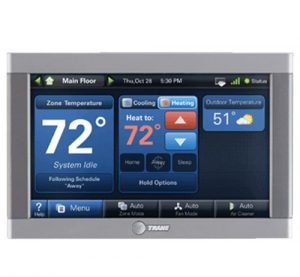Whether you’re nestled in your cozy cabin on Chennault Beach or comfortably stationed in your bungalow up by Japanese Gulch, you’ll know that our Pacific Northwest weather can be a real mixed bag.
To handle unpredictable weather, you need a versatile, efficient, and reliable air conditioning system.
Enter the mini split AC system—your solution for a cool summer and a warm winter.
In this guide, we’ll demystify mini split AC systems, discuss when they’re the best choice, highlight key features to consider, walk you through sizing your unit, and more!
Here’s everything you need to know about mini split AC systems.
Understanding Mini Split AC Systems
Mini split AC systems, also known as ductless systems, are unique cooling and heating solutions for spaces where traditional HVAC units may not be suitable.
They consist of two main components: an outdoor compressor/condenser and one or more indoor air-handling units. Connected by a conduit housing the power cable, refrigerant tubing, suction tubing, and a condensate drain, these systems offer a compact and flexible approach to home comfort.
How Does a Mini Split AC Work?
In a mini split system, the outdoor unit expels heat from the house to the outside during summer, and during winter, it extracts heat from outdoor air and circulates it inside the house. The indoor unit, equipped with an evaporator, disperses the cooled or heated air into the room. This dual action makes mini split ACs a great year-round solution for homes in Mukilteo, WA.
Types of Mini Split ACs
Mini split systems come in two main types: single-zone and multi-zone systems.
Single-zone systems consist of one outdoor unit linked to one indoor unit. They’re ideal for cooling or heating a single room or area in your home.
Pros:
- More affordable compared to multi-zone systems
- Ideal for homes where only one room needs temperature control
Cons:
- Only serves one area or room
- Not efficient if multiple areas need temperature control
Multi-zone systems connect one outdoor unit to multiple indoor units. These are perfect for homes with multiple rooms that require individual temperature control.
Pros:
- Allows for individual temperature settings in different rooms
- Efficient for larger homes with multiple rooms
Cons:
- More expensive due to multiple indoor units
- May require more complex installation
In both types, you have the option to choose between wall-mounted, floor-mounted, or ceiling cassette units for indoor handlers—depending on your space and aesthetic preferences.
When to Choose a Mini Split AC
Mini split systems can be an excellent choice when:
- You’re looking to add AC to a home without ductwork (such as older homes or those heated by radiators).
- You’re building an extension or new addition to your home and don’t want to extend your existing ductwork.
- You want to better control the temperature in specific rooms, or ‘zones’, of your home.
Essential Features of a Mini Split AC
A mini split AC system isn’t a one-size-fits-all solution, and with the myriad options available, choosing the right one can be daunting. Let’s discuss some key features you should look for in your ideal unit.
Energy Efficiency Ratings (SEER, HSPF)
The efficiency of a mini split AC is gauged by two important ratings: the Seasonal Energy Efficiency Ratio (SEER) and the Heating Seasonal Performance Factor (HSPF).
A higher SEER and HSPF rating indicates a more energy-efficient model, which translates to lower electricity bills. Look for a SEER rating of 15 or more and an HSPF rating of 8.5 or more for maximum efficiency.
Number of Zones
Consider the number of zones or rooms you want to control independently. If you’re looking to cool or heat multiple rooms, a multi-zone system will serve you best. If you’re just focusing on a single area, a single-zone system should suffice.
Cooling and Heating Capacities
The capacity of a mini split AC is measured in British Thermal Units (BTUs). For an average room of 200-300 square feet, an AC with a capacity of about 6,000-8,000 BTUs is sufficient. Larger rooms may require a higher BTU capacity.
Inverter Technology
Inverter technology allows the compressor to operate at variable speeds, which leads to more efficient operation and energy usage, and results in more precise temperature control. Inverter-based models may be more expensive upfront but can save you money in the long run due to their energy efficiency.
Noise Level
One of the biggest advantages of mini split AC systems is their quiet operation. Most indoor units operate at a noise level of around 25-35 decibels – which is quieter than a whisper! This feature makes mini splits ideal for bedrooms, offices, and other spaces where quiet operation is preferred.
Air Filtering Capabilities
Good air filtering capabilities not only provide better indoor air quality but also help maintain the system’s efficiency by keeping the interior components clean. Look for models with washable and reusable filters for added convenience.
Remote Control and Smart Home Integration
Modern mini split systems come with remote controls and are often compatible with smart home systems. This means you can control your AC from anywhere in your home, or even away from home, using a smartphone app. This feature adds a layer of convenience and allows for better energy management.
Sizing a Mini Split AC
When it comes to mini split ACs, size does matter. It’s essential to get a system that’s right for your space, not just for comfort, but for energy efficiency and longevity.
Understanding BTUs
The size of a mini split AC is determined by its British Thermal Units (BTUs). As a rule of thumb, you need approximately 20 BTUs per square foot. However, this can vary depending on factors like ceiling height, insulation, and window size.
Here’s a general mini split sizing chart that you can use in a pinch:
| Square Footage | BTUs Needed |
| 150 to 250 sq. ft. | 3,000 – 5,000 BTUs |
| 250 to 300 sq. ft. | 5,000 – 6,000 BTUs |
| 300 to 350 sq. ft. | 6,000 – 7,000 BTUs |
| 350 to 400 sq. ft. | 7,000 – 8,000 BTUs |
| 400 to 450 sq. ft. | 8,000 – 9,000 BTUs |
Note: These are just general calculations. For more personalized measurements, contact a professional like BelRed Energy Solutions.
Other Factors to Consider
In addition to square footage, you should also consider factors such as the number of people regularly in the room, the room’s exposure to sunlight, and the number and size of windows and doors. All these elements can affect your BTU requirement.
Cost Considerations
Investing in a mini split AC system is a significant decision and understanding the associated costs can help you budget effectively.
Costs for mini split systems can range from $2,000 to $14,000, including installation. The cost depends on the brand, size, and number of indoor units.
Reliable Financing Options
BelRed understands that investing in a mini split AC is a significant commitment, which is why they offer flexible financing options. You can enjoy the comfort of a mini split AC without stressing over the financial impact.
To learn more about our offers, please don’t hesitate to reach out. Dial (855) 345-6161 today!
Choosing the Right Brand
With the plethora of brands available on the market, picking the right one can feel overwhelming. However, some brands stand out for their quality, durability, and technological advancements.
BelRed carries a diverse range of top-quality brands and models. Here are some popular brands of mini split ACs available today:
- Mitsubishi: Known for their high-quality systems, Mitsubishi offers mini split ACs that are highly efficient, reliable, and equipped with advanced features such as the “i-see” sensor and 3D air flow technology.
- Daikin: Daikin mini splits are recognized for their smart inverter technology, quiet operation, and energy efficiency. They also offer a broad range of BTU capacities to suit different home sizes.
- Fujitsu: Fujitsu stands out for its innovative design and top-notch energy efficiency. Their systems come with features like a sleep timer, wireless remote control, and high-speed cooling and heating.
- LG: With their sleek design and smart home compatibility, LG mini splits are a favorite among homeowners. Their units offer excellent energy efficiency and a range of capacities.
- Carrier: Known for their reliability and durability, Carrier mini splits also boast energy-saving features and a range of capacities. Their units are built to withstand extreme conditions while providing consistent comfort.
Each of these brands offers a range of options in terms of BTU capacities, energy efficiency, and additional features. Our team can guide you through these options, ensuring you choose a system that perfectly suits your needs and preferences.
Frequently Asked Questions
Can I install a mini split AC by myself?
It’s recommended to have a professional handle the installation due to the complexity of the task. This also ensures the system’s efficiency and longevity.
Is a mini split system energy-efficient?
Yes, particularly those with high SEER and HSPF ratings. These systems can offer considerable savings on energy costs.
How long does a mini split AC last?
With regular maintenance, a mini split AC can last between 10 to 15 years. It’s an investment that pays off in comfort over the years.
Professional Installation and Maintenance
Investing in a mini split AC isn’t just about purchasing the unit; it also involves professional installation and regular maintenance. Both these factors significantly contribute to the efficiency, performance, and longevity of your system.
Professional Installation
The process of installing a mini split AC requires expertise. The placement, angle, and stability of the indoor and outdoor units, along with the layout of the electrical wiring and refrigerant lines, all play a vital role in your system’s performance. BelRed’s team of professionals understands these nuances and ensures proper installation, so your system can perform at its peak for years to come.
Importance of Regular Maintenance
Just like any other equipment, your mini split AC needs regular care to continue running efficiently. Regular maintenance, including cleaning and servicing, helps maintain the efficiency of your AC system, prevents potential issues, and prolongs its lifespan.
Maintenance Programs
Understanding the importance of regular maintenance, BelRed offers annual maintenance programs designed to keep your system in top-notch condition. These programs involve regular check-ups and preventative measures to ensure your system runs smoothly.
Choose BelRed Energy Solutions!
For top-tier AC repair, installation, and maintenance services, look no further than BelRed Energy Solutions. With over 30 years of experience, BelRed’s dedicated team ensures that your mini split AC system operates optimally, keeping your home comfortable year-round. Ready to invest in lasting comfort and efficiency?
Contact BelRed Energy Solutions today – we’re here to help you find the perfect AC solution for your home.







